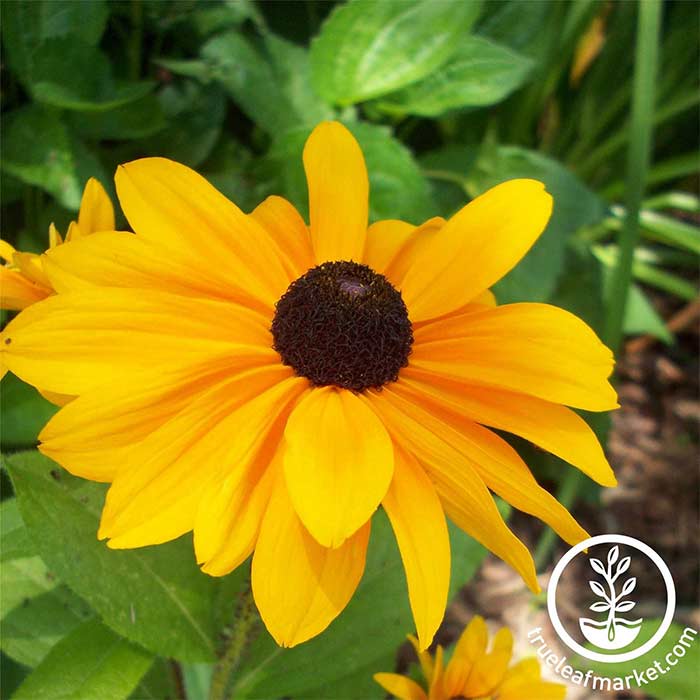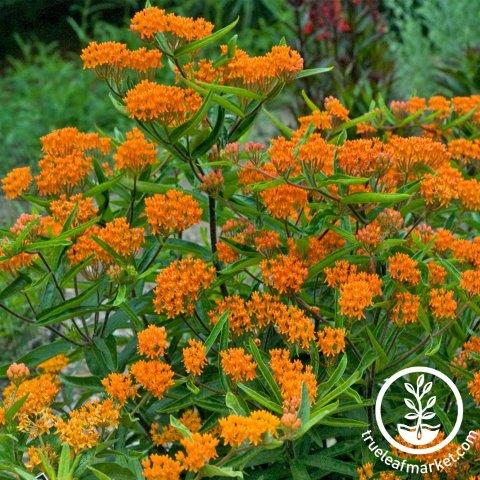
Ashleigh Smith

 |
Written By Lara Wadsworth |
Rolling hills, farmlands, forested valleys, and pristine lakes characterize the American Midwest. This is the region I call home, and I wouldn’t have it any other way. Anyone who lives here is familiar with the wide range of native biodiversity in the wilderness of the Midwest. But, venturing into the cities and suburbs shows a different story. Aphids and other pests plague our gardens and landscape, and we wonder why. The key is biodiversity. Here are 10 plants native to the Midwest that any gardener can easily grow from seed. Each plant also attracts a host of beneficial insects and thus promotes a balanced ecosystem.
Coneflower (Echinacea purpurea)
My favorite North American native is the purple coneflower! The beautiful flowers bloom from June through August and attract important pollinators. In addition to pollinators, the coneflower is home to many other wonderful friends, such as native ladybugs, lacewings, and their larvae, as well as parasitic wasps. These insects do not harm humans or their dwellings but eat aphids, thrips, spider mites, and other garden pests. Planting purple coneflowers also offers a medicinal herb to be ever at the ready. The tea made from their leaves is delicious and nutritious!
Aster (Aster spp.)
These plants are a haven for beneficial insects like green lacewings and ladybugs. Adult green lacewings are known for their delicate, green wings that look like lace, hence their name. They're not only beautiful but also useful, as they play a role in pollination. However, it's their larvae, often called "aphid lions," that are the real MVPs when it comes to pest control. These delightful flowers come in a kaleidoscope of colors, from enchanting purples and blues to serene whites, blooming from late summer into fall. They're not just a treat for the eyes; they're also straightforward to grow from seed, making them a fantastic choice for gardeners of all levels.
Black-Eyed Susans (Rudbeckia hirta)
Rudbeckia is the queen of low-maintenance flowers. My mother-in-law has had a patch of these in front of her home for years, and they never fail to amaze me year after year. The contrasting yellow and black flowers bloom from June, clear through October, and easily thrive in various weather conditions. They attract butterflies with their vibrant hues but also ladybugs, hoverflies, and parasitic wasps. Hoverflies are useful little defenders whose larvae eat various other insects, including thrips and aphids! Black-eyed Susans are incredibly easy to grow from seed but do not become invasive.
Mexican Hat (Ratibida columnifera)
The name suggests this is a Mexican plant, but it comes from the shape of the flower, which looks like a sombrero. This beautiful coneflower can be found all throughout North America. Mexican Hat is a beacon for beneficial predatory insects like minute pirate bugs and big-eyed bugs. These little warriors are fantastic for your garden because they have quite the appetite for common garden pests. Minute pirate bugs are known to feast on thrips, spider mites, and aphid eggs, while big-eyed bugs target a variety of pests, including aphids, mites, and caterpillars.
Milkweed (Asclepias spp.)
Blooming in pink, orange, white, or purple, milkweed is known for being the only food source for monarch caterpillars. While it is critically important for this purpose, it also hosts important predatory wasps and ladybugs. Ladybugs are also attracted to bright colors and fragrant flowers, just like butterflies. Ladybug larvae are alligator-looking bugs that voraciously consume any soft-bodied insects. That includes harmful insect larvae, thrips, aphids, and spider mites. While milkweed is easy to grow from seed, it does need stratification in order to germinate. Stratification is a period of cold exposure which triggers the germination process. Plant the seeds out in early spring or late winter, and you’re good to go!
Coreopsis (Coreopsis lanceolata)
There are various species of Coreopsis, and not all of them are native to the Midwest, but C. lanceolata is! It is a haven for pirate bugs and tachinid flies. The tachinid adult flies eat aphids, but the larvae are incredibly effective at controlling populations of webworms, forest tent caterpillars, tomato fruitworms, corn earworms, and cutworms. The homely yellow blooms of coreopsis bloom from June through July. The seeds are easy to germinate and make a wonderful addition to any garden or landscape.
False Sunflower (Heliopsis heloanthoides)
By choosing to introduce False Sunflower to your garden, you're not just getting a gorgeous display of yellow; you're also setting up an eco-friendly pest control system. These beneficial insects work behind the scenes to keep your garden healthy, reducing the need for chemical interventions. So, planting Heliopsis is a win-win for beauty and sustainability! The vivid yellow blooms grace gardens from early summer to early fall. It's a dream plant for those looking to add a splash of sunshine to their gardens, and it is simple to grow from seed!
Penstemon (Penstemon digitalis)
Also known as Meadow Beardtongue and used widely in landscaping and flower arranging, it is originally a native of the Midwest! The loveable blooms can come in blue, pink, or white and attract bumblebees, butterflies, and predatory wasps. According to the University of Minnesota, Parasitic wasps (a type of predatory wasp) are some of the most important insects in our ecosystem. Yet, they easily go unnoticed and unappreciated. These wasps must use other insects (usually aphids or various types of foliage-eating worms) in order to lay their eggs. This helps to keep these plant-destroying pests in check and balance the ecosystem.
Bee Balm (Monarda didyma or fistulosa)
Also known as Wild Bergamot, these dazzling red or purple blooms are a feast for the eyes from July to August, brightening up any garden space. What's even better? It's super easy to grow from seed, so whether you are a seasoned gardener or are just starting out, you can enjoy its beauty without too much fuss. Yet, Bee Balm isn't just a pretty face. It's a magnet for a type of predatory wasp known as Sand Wasps, which are natural predators of stinkbugs. Stinkbugs are a serious problem for orchards and vegetable crops in the Midwest. Having these specialists on call is invaluable!
Marsh Blazing Star (Liatris spicata)
Liatris is a stunning addition to any garden with its vibrant purple spikes that stand tall and proud from July to September. Some call it Gayfeather, but despite the name variations, it never varies in beauty and utility. Blazing Star is home to parasitic wasps. Now, before you think, "Wasps? In my garden?!", hear me out. These wasps are the good guys, targeting many garden pests such as aphids, caterpillars, and beetle larvae. They lay their eggs inside or on these pests, and when the eggs hatch, the larvae feed on the host insect, effectively controlling their populations. Plus, Blazing Star attracts butterflies, adding even more life and color to your garden.
As you invite beneficial insects into your garden with plants like these, you're beautifying your space and enlisting a natural, efficient pest control squad that works tirelessly to keep your garden healthy. You won’t have to spend hours spraying or hand-removing pests anymore. The key is diversity! The more biodiversity you have in your garden, the lower your chance of succumbing to an infestation.
 |
Lara Wadsworth, True Leaf Market Writer |
I am a native of Southwestern Michigan, where I also reside, and I love all things plants! I got a Bachelor's Degree in Horticulture and found the first work-from-home job I could get. Now, I spend my days writing for TLM, playing with my dog, eating delicious food with my husband, and plotting my next landscape or gardening move. I believe everyone should get down and dirty in the soil now and then. Happy Gardening!
About the Author

I'm Ashleigh Smith, a native to Northern Utah. I first gained a love of gardening with my grandmother as I helped her each summer. I decided to make a career of it and have recently graduated with a Bachelor's degree in Horticulture from Brigham Young University - Idaho. My studies have focused on plant production while I also have experience in Nursery & Garden Center Operations.
Our Recommended Picks
Leave a comment
Your email address will not be published. Required fields are marked *
0 Comments
No Comments yet! Be the first to start a conversation
Further Reading

How to Choose the Right Tobacco Seed Variety for Your Garden
Selecting the right tobacco seed variety can make or break your growing season. For experienced gardeners, this choice isn’t just about aesthetics—it’s about matching your growing environment and goals with the perfect plant genetics. Whether you’re gr...

Ashleigh Smith
2025-10-294 min read0
Everything You Need to Know About Tobacco Seeds
Growing tobacco seeds is an art form for seasoned home gardeners. Whether you’re intrigued by the plant’s ornamental qualities, want to harvest for fresh processing, are curious about heirloom varieties, or simply love the challenge of nurturing delica...

Ashleigh Smith
2025-10-297 min read0
Mild Climate Winter Gardening Guide for Zones 9 & 10: What to Plant and When
Coming soon!

Ashleigh Smith
2025-10-171 min read0
Harvesting the Incredible Health Benefits of Microgreens
Written By Lara Wadsworth Microgreens are young edible seedlings that are harvested when they are just 1-3 inches tall. These quick-growing plants are emerging as an important food source with numerous health benefits. Their nutrient density can be up ...

Ashleigh Smith
2025-09-306 min read1













